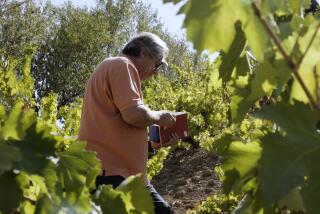Illuminating Armenia’s Medieval Past
- Share via
“Oh Master Yesayi, remember me in your prayers.”
This is the plea of a 14th century Armenian monk and artist, T’oros of Taron, to the abbot of his monastery, Yesayi of Nich.
Made at a time when the Armenian Church was intent on maintaining its unique identity despite overtures from the Roman Catholic hierarchy and power plays by neighboring political factions, T’oros’ plea is heard 700 years later because of the manuscript--the exquisitely illuminated Gospels of Gladzor--that contains it.
In a small, jewel-like illumination, “The Second Storm at Sea,” T’oros’ words are tucked between the feet of Jesus, who stands firmly on the water, and the boat carrying his apostles. It’s one of the 60 pages from the Gladzor Gospels on display at the J. Paul Getty Museum in an exhibition meant to celebrate the 1,700th anniversary of the founding of the Armenian Church, the oldest national church in Christendom.
In keeping with Armenian tradition, the Gladzor Gospels open with a set of richly illustrated Canon Tables, charting the placement of the stories of Christ’s life in the four Gospels. Elaborately decorated architectural elements are surrounded by whimsical plants and birds--”a garden of spiritual pleasure,” says Armenian manuscript scholar Alice Taylor, co-author with Thomas F. Mathews of the book accompanying the exhibition. “They are supposed to help you prepare yourself to enter into the sacred text.”
Gold-encrusted portraits of the evangelists, with the animals symbolically associated with them--the ox in the case of Luke and the lion in the case of Mark, for example--open each Gospel. The facing page, the incipit , or first page of text, is filled with brightly colored birds that have been twisted and turned to form the curvaceous letters of Armenian script.
In medieval times, books like this were luxury objects whose text was accessible only to an educated elite or the clergy, the rare literate members of a widely illiterate population. Handwritten and illustrated on parchment, the books were made of materials that “were extraordinarily expensive,” says the Getty’s curator of manuscripts, Thomas Kren. “Each pair of pages is a good chunk of the back of a sheep. A book that has 300 leaves or more such as [the complete Gladzor Gospels], you’re talking about a flock of sheep. Also, you’re talking about real gold and lapis lazuli. The jewel-like quality of the book reflected the jewel-like character of the materials themselves.”
It also reflects the fact that throughout its history, Armenia’s most prized artistic production has been in the form of architecture and illuminated manuscripts. “The Armenian worldreally looks at books as important things. In Russia, when the city is in danger, you go and get the icons,” Taylor says. “In Armenia, you go and get the Gospel books.”
Such manuscripts were not only objects of rare beauty but also a kind of theological argument. The stories the illustrators chose to illuminate and the way they rendered them provide a window onto the beliefs and practices of a church that evolved independently from both the Roman Catholic and Byzantine traditions, since its founding in 301.
“Gladzor was a very intellectually active monastery,” says Taylor, chair of the humanities and fine arts department at West Los Angeles College. “They thought and wrote a lot about the Holy Scripture. The pictures are exegesis on the text.”
For example, “The Genealogy of Christ,” a New Testament passage that was rarely illuminated in the rest of Christendom, highlights the importance of ancestry to the Armenians. In the Gladzor Gospels, the text is written in pure gold, with rows and rows of Christ’s crowned and haloed ancestors dressed in luxurious blue and red robes gracing the pages.
“It’s a bunch of begats, very boring stuff,” says Taylor, of the words themselves. “But for this audience, it was very interesting because it showed Christ’s place as inheritor of the priesthood. This was important for the Armenians because they had a hereditary priesthood, which is not the norm in Christianity.”
Another illumination, “The Petition of the Canaanite,” shows a woman speaking to Christ over the heads and halos of his apostles.
“The Canaanite woman is calling, ‘You can save my daughter, help me.’ But she’s not a Jew and all these guys are Jews,” explains Taylor, pointing to the apostles. “It’s one of the themes of the Gospels, Christ listening to people even if they’re not from his own tribe. This is an important issue for Armenians, who are living in an area where there are all kinds of people--Catholics, Mongols who were ruling their land, Muslims, Georgians.”
One of the most sensitive issues of the day is the focus of “The Last Supper.” Christ is seated on a gold semicircular table surrounded by his apostles, each with a loaf of unleavened bread. There are two chalices of wine with bread dipped in them and Judas is reaching forward.
“This was Christ’s last Passover meal. He says, ‘This is my body and this is my blood and I want you to eat and drink.’ This is where the Mass comes from, the Eucharist,” Taylor says.
“This [illumination] is a way of saying, ‘We dip, we have our bread in our wine chalice,”’ Taylor says. “‘Not only do we do it, Christ does it. This is how Christ told us to do it.”’
Dipping, however, was not the practice of the Roman Catholic church. When the Armenian Church attempted a rapprochement with the Catholics in the late 13th century, one of the concessions suggested was that the Armenians would stop dipping the bread at the Eucharist.
“They tried to find an ecumenical way to bring these two Christian churches together, but there were riots and murders about ‘Are we going to dip or not?’ Yesayi of Nich said, ‘I’d rather go to hell with my ancestors than go to heaven with the Romans.’ It is hard to understand now, but it was important at the time.”
The intensity accompanying Armenian religiosity can be seen in “The Crucifixion,” where someone has scratched away the faces of Christ’s tormentors. “Somebody took this so seriously that these tormentors had their faces torn off,” Taylor says. “That happens in a lot of Armenian manuscripts. Frequently, you’ll find Judas’ face scratched out. This shows a real different attitude toward manuscripts. This is not an antique that you keep because it’s old. It’s a relic you keep because of its meaning.”
Although the Gladzor Gospels and other surviving manuscripts provide rich material for the study of the Armenian church, the Gladzor monastery has been erased over time, and its precise location remains a mystery. The traces of the Gospels are easier to find.
Shortly after it was finished, the manuscript was sold to a high-ranking family from whom it was seized as war bounty in 1387. The family’s progeny ransomed it, then donated it to another monastery, where a notation was added promising damnation to anyone who might sell the Gospels in the future. Another notation traces the manuscript to a 19th century church in Isfahan, in what was then Persia, and from there it came into the possession of Caro Minasian, an Armenian doctor and rare-book collector living in Isfahan, who sold his collection to UCLA in the 1960s. At the time of the transfer, Minasian, heeding the warning in the manuscript, offered the Gospels to UCLA as a separate gift.
Once at UCLA, the manuscript was removed from an undersized 19th century Persian binding and has never been rebound. That makes it a particularly good subject for exhibition, Kren says. “We can show a manuscript of real quality that is disbound. Often we’ll have a book open and people will say, ‘Oh, that’s marvelous, but what else is there?’ Here you [can] really get a sense of the layers of meaning and range of artistic convention. The book is a picture gallery unto itself.”
Kren, who has collaborated with UCLA’s department of special collections on rare book exhibitions in the past, had long wanted to showcase the Gladzor manuscript, which is part of the Charles E. Young Research Library at the university. “The anniversary turned out to be the perfect occasion,” he says. And Southern California is the perfect place--with its large numbers of Armenian immigrants.
“You can almost pull together the Armenian diaspora. There are Armenians from Persia; Armenians from the current Armenian Republic; Arabic Armenians whose first language is Russian; Armenians who don’t speak Armenian, who grew up in the Valley. There is a whole world of Armenians who can come up here to celebrate this anniversary.” *
*
“THE ARMENIAN GOSPELS OF GLADZOR,” J. Paul Getty Museum, 1200 Getty Center Drive, Brentwood. Dates: Tuesday through Dec. 2. Open Fridays-Saturdays, 10 a.m.-9 p.m.; Tuesdays-Thursdays and Sundays, 10 a.m.-6 p.m. Closed Mondays. Prices: Admission is free but parking reservations, required on weekdays until 4 p.m., are $5. Phone: (310) 440-7300.
More to Read
The biggest entertainment stories
Get our big stories about Hollywood, film, television, music, arts, culture and more right in your inbox as soon as they publish.
You may occasionally receive promotional content from the Los Angeles Times.










